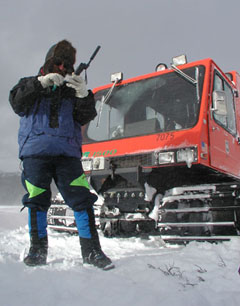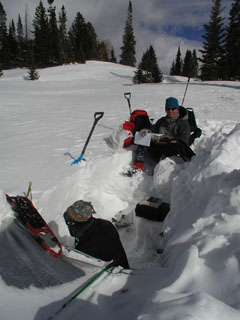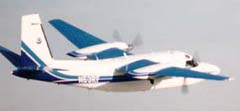| NOAA Magazine || NOAA Home Page |
 February
18, 2003 — For a second year, NOAA
will again join university students and scientists from five federal agencies
in the Cold Land
Processes Field Experiment in the Colorado Rockies to study snowpacks
from the ground, air and space in an effort to better understand water,
weather and climate in cold land areas. These areas, also known as the
“terrestrial cryosphere,” are areas where water is frozen
either seasonally or permanently and snow, ice and frozen soils and vegetation
are common. The CLPX is lead by Don Cline, a NOAA
National Weather Service scientist at the National
Operational Hydrologic Remote Sensing Center in Chanhassen, Minn.
The CLPX is sponsored by the NOAA Office
of Global Programs and both NASA's Terrestrial Hydrology and Earth
Observing System Programs, to address broad interagency objectives in
hydrology, water resources, ecology and atmospheric sciences. Ultimately,
acquiring a greater understanding of snow processes will aid in snowmelt
prediction, flood forecasting, avalanche forecasting, agricultural applications
and improved management of the nation’s water resources. CLPX will
also assist in the developing more effective remote
sensing techniques to study and monitor the nation’s snow covered
landscapes.
February
18, 2003 — For a second year, NOAA
will again join university students and scientists from five federal agencies
in the Cold Land
Processes Field Experiment in the Colorado Rockies to study snowpacks
from the ground, air and space in an effort to better understand water,
weather and climate in cold land areas. These areas, also known as the
“terrestrial cryosphere,” are areas where water is frozen
either seasonally or permanently and snow, ice and frozen soils and vegetation
are common. The CLPX is lead by Don Cline, a NOAA
National Weather Service scientist at the National
Operational Hydrologic Remote Sensing Center in Chanhassen, Minn.
The CLPX is sponsored by the NOAA Office
of Global Programs and both NASA's Terrestrial Hydrology and Earth
Observing System Programs, to address broad interagency objectives in
hydrology, water resources, ecology and atmospheric sciences. Ultimately,
acquiring a greater understanding of snow processes will aid in snowmelt
prediction, flood forecasting, avalanche forecasting, agricultural applications
and improved management of the nation’s water resources. CLPX will
also assist in the developing more effective remote
sensing techniques to study and monitor the nation’s snow covered
landscapes.
The Terrestrial Cryosphere
The terrestrial cryosphere represents a significant proportion of the
Earth’s land surface. Coarse-resolution satellite data estimate
that on average more than 60 percent of the northern hemisphere land surface
has snow cover in midwinter. More than 30 percent of Earth’s total
land surface has seasonal snow, and about 10 percent is covered permanently
by snow and ice. Seasonally and permanently frozen soils occur throughout
higher latitudes and at high elevations, and are estimated to occur over
approximately 35 percent of the Earth’s land surface. Permanently
frozen soils (known as “permafrost”) underlie approximately
26 percent of the Earth’s land surface. However, because these areas
are dynamic; the spatial extents of frozen and thawed areas vary significantly
on daily, seasonal and interannual time scales.
 Why
is the Terrestrial Cryosphere Important?
Why
is the Terrestrial Cryosphere Important?
The terrestrial cryosphere is important because it forms a major
component of the Earth's hydrologic system, and has significant influence
on global weather and climate. Seasonal snow cover and glaciers store
large amounts of fresh water, and are therefore critical components of
the hydrologic cycle. Likewise, seasonal and permanent frost in soils
reduce both infiltration into and migration of water through soils, thus
severely reducing the amount of water that can be stored in soils. By
reducing infiltration, frozen soils can dramatically increase the runoff
generated from melting snow, and are often associated with devastating
snowmelt floods.The importance of seasonally and permanently frozen land
surfaces extends far beyond hydrologic processes. These areas also influence
global weather and climate systems, the geosphere and the biosphere. For
example, depending on whether surface water is in the liquid or frozen
state, there can be important consequences for surface albedo and net
radiation, as well as for latent energy exchanges. The high albedo of
snow covers reflects much of the incoming solar radiation away from the
Earth’s surface, resulting in less energy to warm the surface than
when there is no snow cover. Cold snowpacks also act as a significant
energy sink, since large amounts of available energy are needed to raise
snowpack temperatures and melt the snow. This use of energy influences
weather patterns and air mass characteristics “downstream”
of snow-covered regions. Permanently frozen areas are also important components
of global biogeochemical budgets. In fact, it is estimated that one third
of global carbon is immobilized within permafrost soils. The influence
of seasonally and permanently frozen land surfaces even extends to engineering
in cold regions, trafficability for humans and other animals, and a variety
of hazards and costs associated with living in cold lands.
CLPX Objectives
The CLPX will improve the fundamental understanding of the hydrology,
meteorology, climate and ecology of the terrestrial cryosphere. It will
also provide a baseline set of observations that can be used to gauge
future changes in the extent and characteristics of the terrestrial cryosphere.
With regard to remote sensing science and technology, CLPX will answer
the following questions: Can remote sensing provide information about
the freeze/thaw state of the land surface and about the physical characteristics
of snow, with sufficient accuracy and timeliness to significantly improve
hydrologic forecasts and snow models, mesoscale numerical weather prediction
models and global ecological and biogeochemical models?
 CLPX
Methodology
CLPX
Methodology
This month, NOAA scientists from the National Operational Hydrologic
Remote Sensing Center and the NOAA Environmental
Technology Laboratory will again join researchers from NASA's Goddard
Space Flight Center and Jet Propulsion Laboratory, the USDA Forest Service,
the U.S. Army Corps of Engineers Cold Region Research and Engineering
Lab, the U.S. Geological Survey, the USDA Agricultural Research Service
and graduate students from universities around the world in conducting
the second year of this two-year experiment. NOAA
Corps commissioned officers from the NOAA
Aircraft Operations Center will pilot the NOAA Turbo
Commander aircraft to collect airborne snow water equivalent data
for the experiment. Joining them will be three other aircraft from NASA’s
Dryden Flight Research Center (DC-8 and Twin Otter) and Wallops Flight
Facility, which will be collecting a variety of airborne synthetic aperture
radar, passive microwave, and optical remote sensing data for the CLPX.
The experiment will be conducted in the central Rocky Mountains of the
western United States, where large physiographic gradients provide the
rich array of different terrain, snow, soil and ecological characteristics.
This region of northern Colorado and southern Wyoming provides an ideal
"natural laboratory" for snow research because:
- It contains a wide range of terrain characteristics in a relatively small area, thus giving researchers a broader view of cold-season processes in a small geographic area;
- There is a long record of research on cold-season processes in this area, thus providing an important historical context for the CLPX;
- There is a strong infrastructure of transportation, lodging, food, fuel, power and medical facilities in the area that can provide services relevant to the experiment; and
- The study area contains many different topographic, climatic, hydrologic and ecologic characteristics that can be used as surrogates for cold land regions throughout the globe.
The CLPX is designed to take advantage of seasonal variations in snow and frozen soil conditions. In the same way that the diverse terrain of the study area provides a broad range of snow pack conditions, seasonal variations will allow researches to study the same geographic area under a variety of atmospheric conditions. Field campaigns will be conducted in late winter (mid-February) — when predominantly frozen conditions and dry snow covers are expected, and ecosystems are mostly dormant — and again in early spring (late-March) — when transitional (e.g., frozen and thawed) conditions and predominantly wet snow covers are expected, and ecosystem activities increase. Background data collection for this two-year experiment began in the fall of 2001. The first field campaigns ran from Feb. 19 to 25 and March 24 to 30, 2002, to observe the study areas under both dry snow and wet snow conditions. This schedule will be repeated again in 2003.
 A
Multi-sensor, Multi-scale Approach
A
Multi-sensor, Multi-scale Approach
The experimental design is a multi-sensor, multi-scale approach
to providing the comprehensive data set necessary to address several experiment
objectives. Within a framework of this diverse study area intensive ground,
airborne and spaceborne observations will be collected.
- Ground Observations: More than 60 scientists and students will assist in taking ground measurements during CLPX. Depending on the study area, they will use skis, snowshoes and over-snow vehicles to reach designated study sites. Conducting research on this already rugged terrain will be difficult, since scientists will be carrying 20-30 pound packs (with shovels, probes, scales, radios, GPS units, and safety equipment). One of the major objectives of the CLPX will be to survey snow pack characteristics to measure water content and determine how snow changes with time — including how it melts and how long it takes to melt. To accomplish this, researchers will dig hundreds of snow pits to analyse snow water content, density, temperature, grain size and crystal formation at different depths. Some pits exceed 3 meters depth. Because variations in snow properties influence remotely sensed measurements of snow from space, gaining knowledge as to what space-borne sensors “see” on the ground will be critical in improving the use of remote sensing techniques in this arena.
 Air
and Space-borne Observations: Researchers also will use remote
sensing techniques from both aircraft and satellites (i.e., NASA's Terra
and Aqua satellites) to measure characteristics of snowpack and the
freeze/thaw state of the land surface. NASA will be flying its DC-8
"Airborne Laboratory," P3-B, and Twin Otter aircraft, with
a variety of microwave imaging and other sensors. The NOAA National
Operational Hydrologic Remote Sensing Center Airborne
Snow Survey Program will be flying snow detection sensors onboard
NOAA Turbo Commander aircraft to capture cold land properties throughout
the CLPX study areas. The NOAA Turbo Commander aircraft, supported by
the NOAA Aircraft Operations Center,
NOAA Marine and Aviation Operations and piloted by NOAA Corps commissioned
officers, is used operationally by the NOHRSC to measure snow water
equivalent throughout the nation. Specifically, NOHRSC's
GAMMA instrument will measure terrestrial and atmospheric gamma
radiation, which will be used to determine snow water equivalents.
Air
and Space-borne Observations: Researchers also will use remote
sensing techniques from both aircraft and satellites (i.e., NASA's Terra
and Aqua satellites) to measure characteristics of snowpack and the
freeze/thaw state of the land surface. NASA will be flying its DC-8
"Airborne Laboratory," P3-B, and Twin Otter aircraft, with
a variety of microwave imaging and other sensors. The NOAA National
Operational Hydrologic Remote Sensing Center Airborne
Snow Survey Program will be flying snow detection sensors onboard
NOAA Turbo Commander aircraft to capture cold land properties throughout
the CLPX study areas. The NOAA Turbo Commander aircraft, supported by
the NOAA Aircraft Operations Center,
NOAA Marine and Aviation Operations and piloted by NOAA Corps commissioned
officers, is used operationally by the NOHRSC to measure snow water
equivalent throughout the nation. Specifically, NOHRSC's
GAMMA instrument will measure terrestrial and atmospheric gamma
radiation, which will be used to determine snow water equivalents.
The data
gathered on the ground and from NOAA/NASA aircraft will then be compared
to that obtained by satellites to evaluate the space-borne snow measurements
from NASA satellites (i.e., Terra's Moderate Imaging Spectroradiometer
instrument (MODIS) and Aqua's Advanced Microwave Scanning Radiometer (AMSR)
instrument). By determining the accuracy of the satellites and using that
information to develop improved snow sensors, researchers may someday
be able to measure snow quantity and frozen ground from space anywhere
in the world—without a ground team.
 The
information acquired from CLPX will be used to better understand the formation
and evolution of snowpacks, especially the processes involving the timing
and extent of snowmelt. This in turn will aid in snowmelt prediction (the
processes and timing of snowmelt), flood forecasting, avalanche forecasting,
agricultural applications and improved management of the nation’s
water resources. According to Don Cline, NOAA scientist at NOHRSC and
leader of the CLPX, the “measurements we made during CLPX last year
have already been extremely useful for helping us understand how to update
water and weather forecast models with observed snow information. The
NOHRSC is currently demonstrating a new Snow
Information System, which uses all available ground, airborne and
satellite snow data to update a state-of-the-art snow model for the continental
U.S. The CLPX data collected just last year has helped us to use operationally
available snow data much more effectively”. Likewise, observing
the transitions in snow, water and energy in frozen landscapes will ultimately
help researches design better sensors to measure the water content of
snow from space. Ultimately, CLPX will allow researches to develop models,
which will extend local-scale understanding of water fluxes, storage and
transformations to regional and global scales.
The
information acquired from CLPX will be used to better understand the formation
and evolution of snowpacks, especially the processes involving the timing
and extent of snowmelt. This in turn will aid in snowmelt prediction (the
processes and timing of snowmelt), flood forecasting, avalanche forecasting,
agricultural applications and improved management of the nation’s
water resources. According to Don Cline, NOAA scientist at NOHRSC and
leader of the CLPX, the “measurements we made during CLPX last year
have already been extremely useful for helping us understand how to update
water and weather forecast models with observed snow information. The
NOHRSC is currently demonstrating a new Snow
Information System, which uses all available ground, airborne and
satellite snow data to update a state-of-the-art snow model for the continental
U.S. The CLPX data collected just last year has helped us to use operationally
available snow data much more effectively”. Likewise, observing
the transitions in snow, water and energy in frozen landscapes will ultimately
help researches design better sensors to measure the water content of
snow from space. Ultimately, CLPX will allow researches to develop models,
which will extend local-scale understanding of water fluxes, storage and
transformations to regional and global scales.
Relevant
Web Sites
NOAA
CLPX
NASA Land Surface Hydrology Program
U.S. Army Corps of Engineers Research and Development Center
USDA Frasier Experimental Forest
For reporters
who would like to attend the media day at the CLPX:
To arrange field dates, contact: Kent Laborde or Scott Smullen, NOAA Public
Affairs, Telephone: (202) 482-5757 or (202) 482-1097
Media
Contacts:
Kent
Laborde, NOAA, (202) 482-5757 or
Scott Smullen, NOAA,
(202) 482-6090